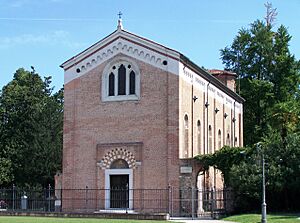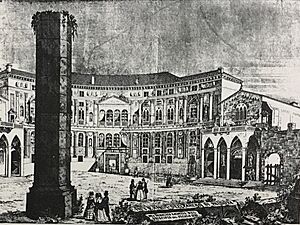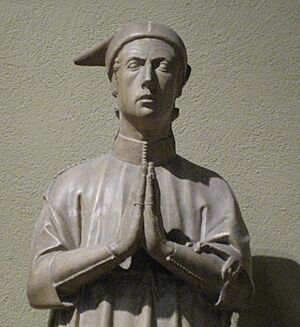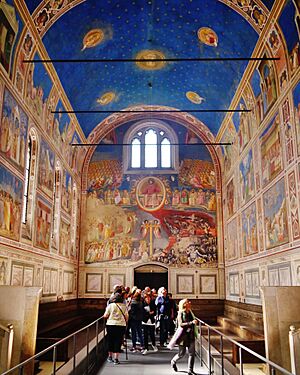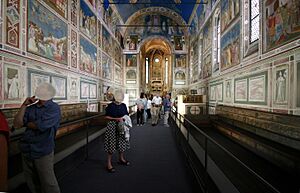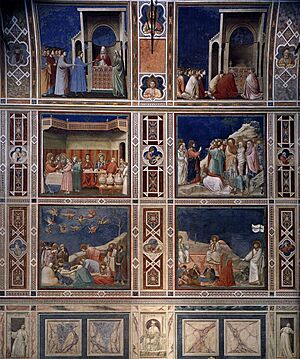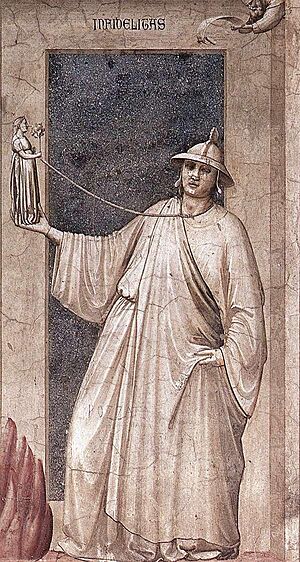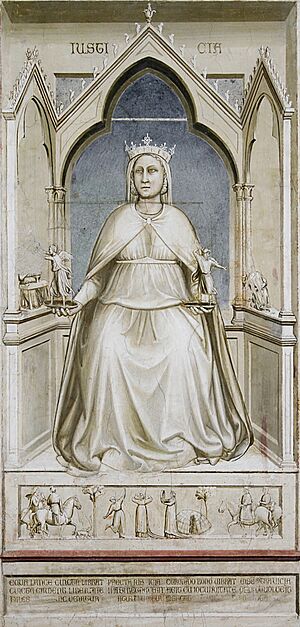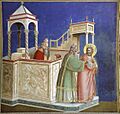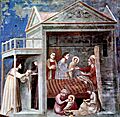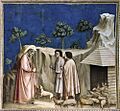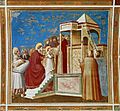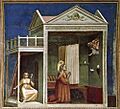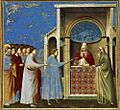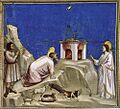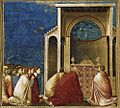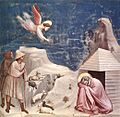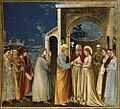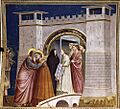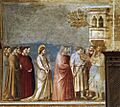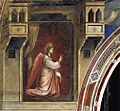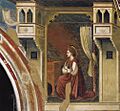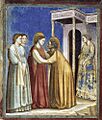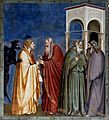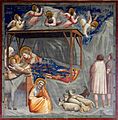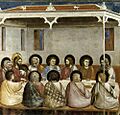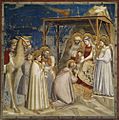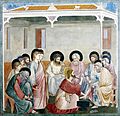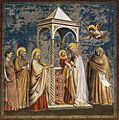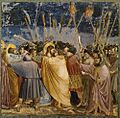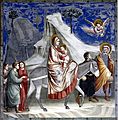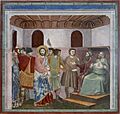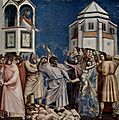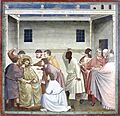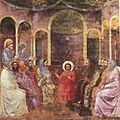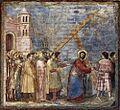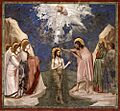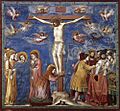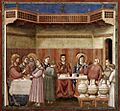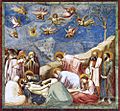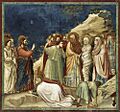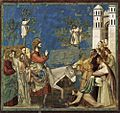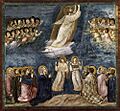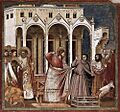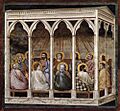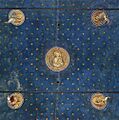Scrovegni Chapel facts for kids
| UNESCO World Heritage Site | |
|---|---|
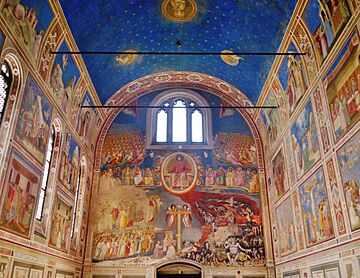
The Last Judgment in the Scrovegni Chapel
|
|
| Location | Padua, Veneto, Italy |
| Criteria | Cultural: (ii), (iii) |
| Inscription | 2021 (45th Session) |
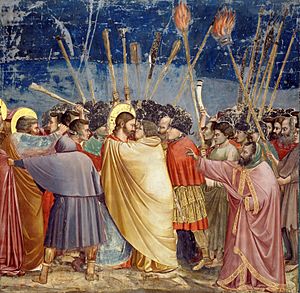
The Scrovegni Chapel (which in Italian is Cappella degli Scrovegni), also called the Arena Chapel, is a small church. It is next to an old monastery in Padua, a city in the Veneto region of Italy. Today, the chapel and monastery are part of the Musei Civici di Padova museum complex.
This chapel is famous for its amazing fresco paintings by Giotto. He finished them around 1305. These paintings are a very important part of Western art. In 2021, the chapel became a UNESCO World Heritage Site. This means it is a special place recognized for its global importance. The frescoes in the Scrovegni Chapel started a new way of painting murals. They changed art for about 100 years!
Contents
What Makes the Scrovegni Chapel Special?
Giotto and his team painted every inside surface of the chapel. This includes all the walls and the ceiling. The main part of the chapel is about 20 meters long and 8 meters wide. The paintings tell many stories. The biggest parts show the Life of Christ and the Life of the Virgin Mary.
On the wall where you enter, there is a huge painting called the Last Judgement. There are also paintings in grey (called grisaille) that show different Vices and Virtues.
The church was first opened on March 25, 1303. It was fully ready in 1305. Many of Giotto's paintings focus on the life of the Virgin Mary. They celebrate her important role in human salvation. The chapel is also called the Arena Chapel. This is because it was built on land that used to be a Roman arena.
The Chapel's Story
How It Was Built and Decorated
A rich banker from Padua, Enrico Scrovegni, asked Giotto to paint the Arena Chapel. In the early 1300s, Enrico bought the land where the old Roman arena stood. He built his fancy palace there, and the chapel was next to it. Enrico wanted the chapel to be his family's private prayer place. It was also meant to be a tomb for himself and his wife.
Enrico hired Giotto, a famous painter from Florence. Giotto had worked in other cities before coming to Padua. He was already well-known for his art.
We know when Giotto worked on the chapel from old records. Enrico bought the land in 1300. The bishop allowed the building before 1302. The chapel was first blessed on March 25, 1303. The Pope even offered a special blessing for visitors in 1304. The chapel was fully finished on March 25, 1305. So, Giotto painted the frescoes between March 1303 and March 1305.
Giotto was about 36-38 years old when he worked on the chapel. He had a team of about 40 helpers. They figured it took 625 "work days" to paint the chapel. A "work day" meant painting a part of the fresco before the plaster dried.
In 1305, some monks nearby complained. They said Scrovegni was turning his private chapel into a public church. This would compete with their own church. We don't know exactly what happened. But it seems the large back part of the church was taken down. This part is shown in Giotto's painting of the Last Judgement. Enrico had planned for his tomb to be in this area.
The current back part of the chapel looks a bit unfinished. Some frescoes there were painted after Giotto's work. An unknown artist, called "The Master of the Scrovegni Choir," painted these scenes. He worked about 20 years after Giotto. His paintings show the last part of Mary's life on Earth.
Modern Times
The chapel was once connected to the Scrovegni palace. This palace was built on the remains of the old Roman arena. The palace was torn down in 1827. Its valuable materials were sold, and new buildings were put there.
The city of Padua bought the chapel in 1881. They decided to remove the new buildings and restore the chapel.
In 2001, a big restoration project began. Experts worked to clean and fix Giotto's frescoes. Before visitors enter, they wait in a special room. This room helps to lower body humidity and filter out dust. This protects the delicate paintings. In March 2002, the chapel reopened. It looked as beautiful as it did when it was first painted.
There are still some small issues. For example, the crypt under the chapel sometimes floods. This is because of water underground. Also, some cement parts added in the 1960s might affect the building's strength.
Understanding the Paintings
Giotto painted the entire inside of the chapel. The paintings are arranged in four rows, or "tiers." Each tier shows different parts of sacred stories. The chapel has an unusual shape, with six windows on one side. This shape helped decide how the paintings were laid out.
Painting cycles showing the Life of Christ and the Life of the Virgin were very popular. Giotto's cycle is huge and covers many events. This shows how important the project was. Giotto's new style made his figures look more real. His paintings were also very clear and easy to understand.
The paintings tell the story of salvation. It starts high up with God telling the Archangel Gabriel to announce Mary's pregnancy. Then come the stories of Joachim and Anne (Mary's parents). After that, the stories of Mary herself. The Annunciation and the Visitation follow.
The middle rows show the stories of Christ. The scene where Judas agrees to betray Jesus is on the entrance arch. The bottom rows show Christ's suffering and his return to life. The last painting on the north wall shows Pentecost. The very bottom row has paintings of Vices (bad habits) and Virtues (good qualities). The wall at the entrance shows the Last Judgment.
Here are some of the main stories you can see:
- Stories of Mary's Parents and Mary: These include Joachim being sent away, angels talking to Anna, Mary's birth, and her marriage.
- Stories of Jesus's Early Life: Such as his birth, the wise men visiting, his presentation at the temple, and the flight to Egypt.
- Jesus's Public Life: Including his baptism, the wedding at Cana, raising Lazarus from the dead, and entering Jerusalem.
- Jesus's Last Days: The Last Supper, the Kiss of Judas, Jesus before Caiaphas, the Crucifixion, and his return to life.
The ceiling shows the "eighth day," which means eternity. It has planets (with prophets inside) and two suns (God and Mary with Jesus). The blue sky is filled with eight-point stars, symbolizing endlessness.
The Vices and Virtues Paintings
On the bottom parts of the side walls, there are 14 paintings. They show single figures of Vices (bad traits) on the north wall and Virtues (good traits) on the south wall. Each figure has its name in Latin above it. These paintings represent the time between Jesus's birth and the Final Judgment.
Some experts believe the Vices and Virtues are meant to be read in a special order. They suggest you start from the altar and move towards the entrance. It's not just "Vices first, then Virtues." Instead, it goes from Vice 1 to Virtue 1, then Vice 2 to Virtue 2, and so on.
These Vices and Virtues show how people can become better. With the help of Virtues, people can overcome their bad habits (Vices). This idea comes from the teachings of Saint Augustine.
For example, Stultitia (Foolishness) is the inability to tell right from wrong. Its opposite is Prudencia (Prudence), which means moral intelligence. Inconstantia (Inconstancy) is being unstable. Its opposite is Fortitudo (Fortitude), which means strength of mind. Ira (Wrath) is anger. Its opposite is Temperantia (Temperance), which means inner balance and control over desires.
These first virtues help people improve themselves. They lead to earthly happiness.
Then come the "theological virtues." To reach heaven, people need divine guidance. Fides (Faith) means believing in God. Karitas (Charity) helps overcome selfishness and envy. Finally, Spes (Hope) helps against despair. Hope means actively trusting in God's future blessings.
This whole program of Vices and Virtues is like a "therapy for the soul." It shows how people can heal themselves and grow closer to God.
In Books
Giotto's painting of Charity is mentioned often in a famous book called Remembrance of Things Past by Marcel Proust. A character named Mr. Swann compares a kitchen maid to this painting. It becomes a funny inside joke between him and the narrator.
Images for kids


